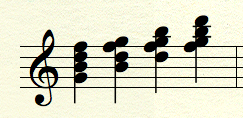Chord Inversion
In previous installments of Music Theory Fridays we’ve gone over the chords in a major scale and gone over how every chord except vii functions.
So far each chord has been in what’s called “root position.” That is, the lowest note of the chord is the root or scale degree from which the chord is built. However, chords don’t always have to be in root position. Inversion is a way to change the lowest note and add more variety to a chord progression.
Inversion Explained
Chord inversion simply means taking another note and putting it in the bottom voice of the chord. If we have a C major chord (notes C, E and G) and put E in the lowest voice (play a c major shape with the open sixth string included), it become a different inversion. Like wise we can stick G in the bass for that chord to be yet another inversion of C major.
How we notate these inversions is by sticking some subscripts on Roman numerals. These subscripts indicate the interval structure above the bass. So 6/3 means that there’s a sixth and third above the lowest note. To go back to our C major example: Lets say we’re in the Key of C major. This makes the C major chord tonic or “I”. If E is in the bass, this chord is said to be in first inversion and it notate like this…

If G is in the bass, we label I like this…

First inversion is sometimes called 6/3 inversion and second, 6/4 inversion. These labels remain constant for any traid (three note chord). So there’s such at thing as ii6/3, etc. Here’s the notation of the all chords in C major in their inversions. The first is first inversion (third of the chord in the lowest voice) and the second is second inversion (fifth of the chord in the lowest voice).

7th chords, such at V7, have three inversions because they have three notes other than the root. The names are a bit different; the Roman numerals are as follows (all notated using V).
Here are the inversion of V7 in notation (key of C major)
Chord Functions
In previous installments we’ve explained how tonic and dominant function and what ii, IV and vi do. Here’s a brief summary:
- Tonic is home
- Dominant leads to tonic
- ii, IV and vi are intermediate harmony. They lead away from tonic and to dominant
When we mix inversions into the game nothing really changes. The basic functions are still there! But the rules change a bit as each inversion has typical functions. Here’s a basic overview:
Tonic is still home. I6/3 is now a stop along the journey from I to V. Tonic in first inversion is somewhat stable, but still has a tendency to sound unfinished – it wants to go somewhere
Dominant in root position still leads strongly to I. V6 or V6/5 functions as a lower neighbor to tonic. Remember that our lead tone (the third of a V chord) must resolve upwards to one. This rule can be broken sometimes, but not when that leading tone is in the highest or lowest voice. With dominant in first inversion the leading tone is the lowest voice and must resolve upwards. V4/3 is a passing chord that’s used when moving between I and I6 yielding the progression I V4/3 I6. vii6 can also be used instead of V4/3 – the chords are interchangeable. V4/2 is interesting. The other rule about resolving V7 to I is that the 7th must resolve downward to the third of the tonic chord. In this inversion of V the 7th is in the lowest voice and must resolve. Which means V4/2 has pretty much one function: to lead to I6.
ii and IV and thier inversions still function the same way: they move to V. Most commonly ii6 and IV6 are used. In fact, 6/4 chord (second inversions) are rarely used outside of very specific circumstances. vi6 is interesting because it has tonic as the lowest note. Regardless of what’s over top of a tonic lowest voice, our ear tends to perceive it as relatively stable. vi6 functions as a substitute for I. If you want to see a great example of this, take a look at the first two measures of Villa-Lobos’ Etude no. 1. He moves I vi6 then back to I in the third measure. vi6 is a way of adding variety.
A Note About the “Rules”
It’s important to say that these rules outlined here are generalizations. Composers break the rules all the time! And in the 20C and today there are no rules on how to write music. Chords can move however you wish. Using this system is useful for understanding the harmony of the “common practice period” which is roughly Bach to 1900ish. It’s also important to understand that theory follows practice. Theory does not define practice. Music Theory is an attempt to explain phenomenon that were already happening in music.



